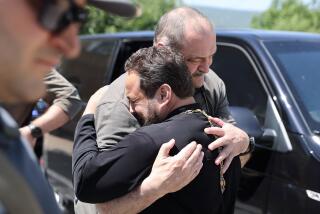Soviet ‘Laboratory of National Relations’ : 60 Ethnic Groups Call Dagestan Home
- Share via
MAKHACHKALA, Soviet Union — According to legend, when Allah was distributing the world’s languages like corn from a sack, he stumbled on the mountains and spilled the seeds of 32 local tongues in an area of 19,300 square miles between Georgia and Azerbaijan.
This is now the small, autonomous Soviet republic of Dagestan, where more than 60 ethnic groups live and which local Communist Party officials call a “laboratory of national relations.”
Many of the nationalities in this laboratory come from different parts of the Soviet Union, such as the Ukraine and Byelorussia, and all are now united by the Russian language.
Although hesitating to hold up Dagestan as a model for the whole Soviet Union, the officials said that ethnic relations in the republic were relaxed and generally problem-free.
Correspondents Tour
The Soviet Foreign Ministry hosted a party of foreign correspondents on a weeklong visit to this little-known corner of the Caspian Sea and clearly wanted to show national relations at their best following ethnic disturbances in the republics of Kazakhstan, Kirgizia and Moldavia.
In the worst reported incident, two people died last December in nationalist riots in the Kazakh capital of Alma Ata, later blamed on social discontent arising from corruption under ousted Kazakh leader Dinmukhamed Kunayev.
After the riots, Soviet leader Mikhail S. Gorbachev demanded a strengthening of “internationalist” education to stamp out nationalist tendencies, which he said were causing concern in a number of Soviet republics.
Asked whether his republic--the Russian Federation--ever experienced ethnic tensions, Dagestan Communist Party First Secretary Yusupov Magomed told reporters:
“We sometimes have small problems, and it is important to ensure social equality on an objective basis. But we have never seen anything like the events in Kazakhstan.”
Representation Guaranteed
Magomed, from the majority Avartsi group, added that proportional representation was guaranteed in the republic’s political institutions and that newspapers and radio broadcasts were produced in 11 local languages as well as Russian.
The total population of 1.8 million people includes Avartsi--the largest ethnic group with more than 400,000 members--Dargintsi, Lezgins and Laktsi.
Some small groups, such as the Farsi-speaking Jewish Tats, have only a few thousand members.
No Group Too Powerful
“I think national relations are easier here because many groups live together and so none becomes too powerful,” said Bakhtiar Akhmedkhanov, a young Kumik whose people account for about 12% of the population.
Russians make up about 11% of the population, and Akhmedkhanov said there was no resentment against them comparable to the anti-Russian feeling that can sometimes be detected in republics such as the Baltic states.
Traditions Preserved
The different ethnic groups appear to preserve their traditions, which was evident at the disco in Makhachkala on Friday night when a group of young Lezgins quickly tired of the standard soft Soviet rock music and began dancing their own wilder steps to more Oriental strains.
High up in the mist-covered mountains, the Kubachi, a branch of the Darginzi people, still practice their gentle art of decorating knives for traditionally more aggressive tribes. They also produce fine engraved gold and silver jewelry and tableware for export.
Muslim family values also seem to hold strong. In Dagestan, with an annual population growth of 2%, many “hero mothers” are to be found with 10 or more children.
But the actual practice of the Islamic religion appears to be weakening.
More to Read
Sign up for Essential California
The most important California stories and recommendations in your inbox every morning.
You may occasionally receive promotional content from the Los Angeles Times.












